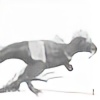HOME | DD
 Saberrex — Hadrolopus
by-nc-sa
Saberrex — Hadrolopus
by-nc-sa

Published: 2013-08-30 01:42:16 +0000 UTC; Views: 1521; Favourites: 26; Downloads: 4
Redirect to original
Description
HadrolopusHadrolopus
Meaning: Bulky Crest
Description: Large ornithopod
Species: H. magnacristus, H. longicristus, H. americanensis
Family: Hadrosauridae, Lambeosaurinae
Length: 44-46 feet
Lifestyle: Grazer, low browser
Range: North America, Eurasia, Africa
Distinguishing features: A very common, long legged hadrosaur, Hadrolopus is the near reincarnation of its ancestors Parasaurolophus and Charonosaurus, even to the extent of its herd-dwelling nature. There is little distinction between them at first glance. It does have its differences, such as paired horns above its eyes, which merge into a long tubular crest, as well as longer legs, cloven hooves on its front feet, and a sail of skin that runs from the crest to the end of the neck. In color, it is a noble blue, with the sail of the crest being royal green with translucent spots of yellow. Its crest is also a deep red and is up to four feet long in large males. Females’ crests are smaller and more curved while juveniles of both sexes are crestless. Bulls are larger than females by a few feet, and are dominant in the herd hierarchy. The males rarely fight, even during breeding season, for dominant bulls are usually closely related, and fights only break out when there is little food to go around. During the breeding season, males display in leks, and try to impress a female of their choosing. If she accepts him, they will pair for life, if not; he will simply have to try his luck elsewhere. Hadrolopus are communal nesters, laying eggs in nests in a sheltered nesting ground, usually away from the prying eyes of predators. They will hatch after three months’ incubation, and like many hadrosaur juveniles, are covered in feathery down, which they shed once they are a year old. The juveniles stay with their parents until they are four years old, and will then live out their own lives in the herd, lives that can be as long as forty years.
Habits and Habitat: Extremely common, Hadrolopus is happiest in herds that can number up to a thousand or more. In Kenya, their herds are so large they result in one of the most massive migrations in the world. And following them are of course, are flesh-lusting predators ranging from dromaeosaurs and Pristichampsid crocodiles, to giants like Ursusaurs and V. rexes, who constantly weed out the weak and old. Despite these threats, they are no easy meal and are usually left alone. Opportunistic feeders, Hadrolopus will eat nearly any plant, and feed indiscriminately, often in the company of other large herbivores, such as ceratopsians, other hadrosaurs, and in some cases, Stegocerastes stegosaurs. They are also highly adept at spotting predators, and many smaller herbivores use them as protection because of this. This, plus their highly sensitive sense of smell, provides many herbivores with a chance to escape predators.




















